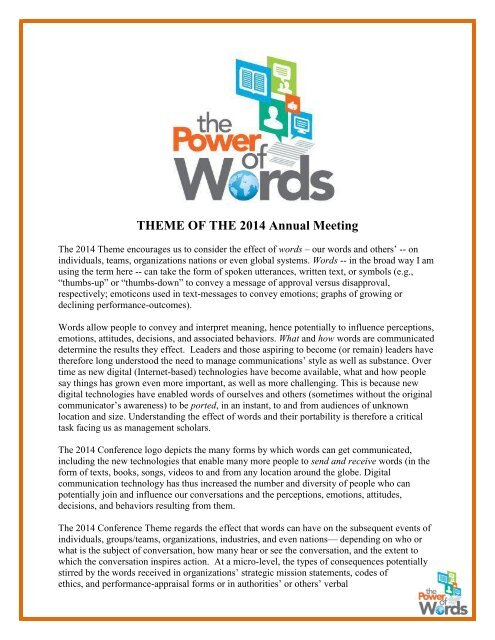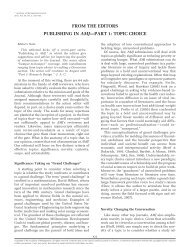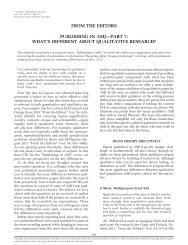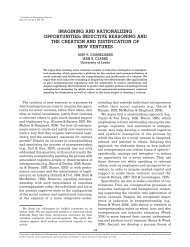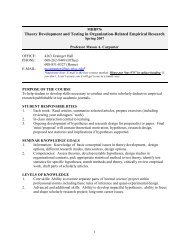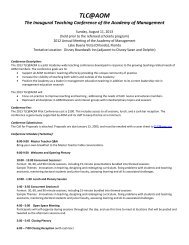The Power of Words - Academy of Management
The Power of Words - Academy of Management
The Power of Words - Academy of Management
Create successful ePaper yourself
Turn your PDF publications into a flip-book with our unique Google optimized e-Paper software.
THEME OF THE 2014 Annual Meeting<br />
<strong>The</strong> 2014 <strong>The</strong>me encourages us to consider the effect <strong>of</strong> words – our words and others’ -- on<br />
individuals, teams, organizations nations or even global systems. <strong>Words</strong> -- in the broad way I am<br />
using the term here -- can take the form <strong>of</strong> spoken utterances, written text, or symbols (e.g.,<br />
“thumbs-up” or “thumbs-down” to convey a message <strong>of</strong> approval versus disapproval,<br />
respectively; emoticons used in text-messages to convey emotions; graphs <strong>of</strong> growing or<br />
declining performance-outcomes).<br />
<strong>Words</strong> allow people to convey and interpret meaning, hence potentially to influence perceptions,<br />
emotions, attitudes, decisions, and associated behaviors. What and how words are communicated<br />
determine the results they effect. Leaders and those aspiring to become (or remain) leaders have<br />
therefore long understood the need to manage communications’ style as well as substance. Over<br />
time as new digital (Internet-based) technologies have become available, what and how people<br />
say things has grown even more important, as well as more challenging. This is because new<br />
digital technologies have enabled words <strong>of</strong> ourselves and others (sometimes without the original<br />
communicator’s awareness) to be ported, in an instant, to and from audiences <strong>of</strong> unknown<br />
location and size. Understanding the effect <strong>of</strong> words and their portability is therefore a critical<br />
task facing us as management scholars.<br />
<strong>The</strong> 2014 Conference logo depicts the many forms by which words can get communicated,<br />
including the new technologies that enable many more people to send and receive words (in the<br />
form <strong>of</strong> texts, books, songs, videos to and from any location around the globe. Digital<br />
communication technology has thus increased the number and diversity <strong>of</strong> people who can<br />
potentially join and influence our conversations and the perceptions, emotions, attitudes,<br />
decisions, and behaviors resulting from them.<br />
<strong>The</strong> 2014 Conference <strong>The</strong>me regards the effect that words can have on the subsequent events <strong>of</strong><br />
individuals, groups/teams, organizations, industries, and even nations— depending on who or<br />
what is the subject <strong>of</strong> conversation, how many hear or see the conversation, and the extent to<br />
which the conversation inspires action. At a micro-level, the types <strong>of</strong> consequences potentially<br />
stirred by the words received in organizations’ strategic mission statements, codes <strong>of</strong><br />
ethics, and performance-appraisal forms or in authorities’ or others’ verbal
communications may include varying levels <strong>of</strong> initiative-taking, creativity, innovativeness,<br />
ethicality, inclusionary behavior, cross-cultural sensitivity, and performance-quality by<br />
individuals and teams. At a more macro-level, the types <strong>of</strong> consequences inspired by words in<br />
texts and speeches delivered by authorities or others include organizational-, industry-, and even<br />
country-level outcomes (e.g., varying levels <strong>of</strong> organizations’ innovativeness, institutionalized<br />
corruption, exclusionary (diversity-unfriendly) climates or cultures, and economic performance<br />
<strong>of</strong> organizations or nations).<br />
Digital technologies have increased the speed with which our own and others’ words can be<br />
received and sent (and potentially also with the original communications modified in the<br />
process), thereby enabling many more people (<strong>of</strong> varying levels <strong>of</strong> authority) to contribute to,<br />
and shape, conversations they hear or see. This has made it more challenging for individuals,<br />
organizations, and nations’ governments to control the words that others read or hear about<br />
them. Additionally, digital technologies’ portability <strong>of</strong> words have changed the trajectory <strong>of</strong><br />
entire industries, accelerating the demise <strong>of</strong> some (e.g., independent book stores and musical<br />
record stores, newspapers and textbooks), and accelerating the formation <strong>of</strong> others (webinars, I-<br />
Tunes, I-Books, E-books, E-newspapers, etc.). Although digital technologies make it far easier to<br />
communicate with people across country borders and cultures, this ease can also enhance the<br />
frequency <strong>of</strong> cross-cultural misunderstanding since words (e.g., colloquialisms) and symbols<br />
representing them (e.g., a “thumbs up” to indicate approval) are <strong>of</strong>ten interpreted differently<br />
across cultures.<br />
<strong>The</strong> effects <strong>of</strong> words and word-carrying technologies, as well as the interactive-effect <strong>of</strong><br />
messages and the channel carrying them, have management implications in need <strong>of</strong> scholarly<br />
attention. Possible questions include:<br />
1. How is employee- or team-performance outcomes (e.g., perceptions, organizational- or teamidentity,<br />
work-related attitudes, task-related decisions, or behaviors) influenced by the words<br />
associated with organizations’ strategic mission statements, codes <strong>of</strong> ethics, and performanceappraisal<br />
forms? How might the latter relationships change when employees see their<br />
organization (or individuals representing it) “talked about” favorably or unfavorably in blogs,<br />
social media-sites, or tweets, and re-tweets?<br />
2. How are new communication technologies affecting how managers pursue goals such as<br />
setting norms, motivating desired employee or team behavior, enhancing employee wellbeing,<br />
creating and sustaining desired team or organizational climates <strong>of</strong> justice and ethicality,<br />
creativity, inclusivity, high-performance? Does the shift from printed to digitized forms change<br />
the meaning <strong>of</strong> organizational texts such as vision and mission statements, codes <strong>of</strong> ethics,<br />
handbooks, rules and bylaws, operation manuals, templates, performance-appraisal forms,<br />
strategic plans, business contracts, historical documentation?<br />
3. How is organizational effectiveness (e.g., pr<strong>of</strong>its, customer satisfaction, sales, repeat-business,<br />
referrals, etc.) affected when the organizations use social media such as twitter, blogs,<br />
etc.? And at a more micro-level, when are individuals’ use <strong>of</strong> social media more versus<br />
less likely to be effective in mobilizing collective voice about desired changes? How<br />
might antecedents to individuals’ effectiveness as social media-reliant change-agents<br />
inform change-initiating or change-managing processes used by employees, managers,<br />
business, or governmental-leaders who wish to mobilize support for their requests?
4. Given the ease with which digital content can be duplicated (as compared to print media), how<br />
are these new technologies affecting the way organizations deal with privacy and security?<br />
Relatedly, what does privacy mean in the internet age? Different countries seem to be legislating<br />
different norms in this regard: is there any convergence in view? How do individual employees<br />
and consumers navigate this new world?<br />
5. What qualities distinguish the businesses and industries that have thrived rather than died as a<br />
result <strong>of</strong> this technological revolution? What can we learn from these other industries as<br />
management educators?<br />
6. What improvements may be needed to prior theorizing and empirically-guided advice about<br />
antecedents to (interpersonal or organizational) legitimacy and related outcomes (e.g.,<br />
individuals’ or organizations’ subsequent reputation and persuasiveness) in light <strong>of</strong> the fact that<br />
it is possible for an image-damaging message-- including a rating <strong>of</strong> thumbs-up (liking) or<br />
thumbs-down (disliking)-- to be anonymously electronically posted, blogged, tweeted, and/or retweeted<br />
by those whose goal is to undermine the organization or members <strong>of</strong> it, such as business<br />
competitors, angry employees or former employees, and/or coworkers who envy higherperforming<br />
peers?<br />
7. How do differences in language-fluency affect processes and outcomes <strong>of</strong> multicultural or<br />
multinational teams? What practices help to enhance inclusiveness among members <strong>of</strong> such<br />
teams and to overcome (unintended or intended) exclusivity when members <strong>of</strong> such teams speak<br />
a language unknown to other members? How can digital communication technologies be used to<br />
facilitate the work <strong>of</strong> culturally-diverse and transnational teams? Does the frequency <strong>of</strong> crossregion<br />
conversations increase employees’ understanding <strong>of</strong> and comfort with cultural<br />
differences?<br />
8. How have new digital communication technologies enabled the construction <strong>of</strong> new<br />
vocabularies and forms <strong>of</strong> communication that have helped to alter extant fields (e.g., business,<br />
education, non-pr<strong>of</strong>its) by enabling the introduction <strong>of</strong> new logics and practices? In turn, how do<br />
organizations cope with the resultant institutional complexity-- that is, the varied pressures they<br />
face associated with multiple institutional logics?<br />
9. How will digital communication technologies impact the way we conduct and communicate<br />
our scholarship and teaching? For example, how does access to digitized texts or conversations<br />
affect our ability to understand organizational phenomena? How will journals’ transition from<br />
print- to online-forms and from paid-journals to open source influence the conduct <strong>of</strong> science,<br />
the evaluation <strong>of</strong> science, and the delivery <strong>of</strong> scientific findings? How will the transition from<br />
face-to-face classroom interaction to on-line virtual interaction with students affect access to<br />
education, the quality <strong>of</strong> education, and the lives <strong>of</strong> educators?<br />
In summary, the 2014 <strong>The</strong>me— “<strong>The</strong> <strong>Power</strong> <strong>of</strong> <strong>Words</strong>”— encourages submissions (at all levels<br />
<strong>of</strong> analysis) that focus on the many forms <strong>of</strong> words in organizations and the ways in which they<br />
facilitate or hinder the outcomes that various organizational stakeholders seek. In so doing, it is<br />
my hope that the 2014 Program may help uncover knowledge on how organizational<br />
stakeholders can leverage the power in words to bring about positive changes!<br />
Debra L. Shapiro,<br />
Vice President and 2014 Program-Chair, <strong>Academy</strong> <strong>of</strong> <strong>Management</strong>


